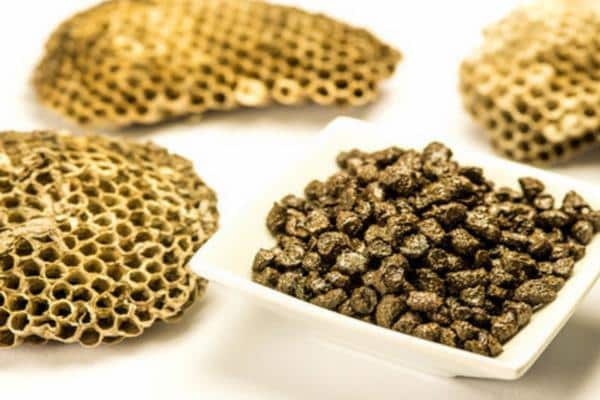Propolis, also called bee putty, is a product made by bees with exceptional properties. This sticky resin contains many beneficial substances that make propolis, a powerful antioxidant that fights free radicals. Bee putty has antibacterial, antiviral and antifungal properties, which is why it has been used in medicine for years. It is useful in treating colds and flu, as well as in relieving inflammation of the throat, mouth and gums. At the same time, it effectively strengthens the immune system. In addition, propolis perfectly restores the skin, soothes spots and acne and accelerates wound healing. Why use bee putty?
What is propolis?
Propolis (bee putty) is made by bees from resin from the buds of deciduous trees such as alder, poplar, willow, birch and chestnut, as well as from insect waxes. Bees use it to seal and protect their nests. Depending on the raw material, propolis can be orange, red, brown, gray, dark green or black. Below 15 degrees, the bee putty has a hard and brittle texture, above 36 degrees it becomes soft and plastic, and at 90 degrees it melts. Propolis has a very rich composition, it contains resin, wax, pollen, polyphenols, flavonoids, polysaccharides, essential oils and trace elements. This allows you to use it in medicine and cosmetology.
Propolis Properties
Propolis can be called a natural antibiotic, since it exhibits antibacterial, antiviral and antifungal properties. Numerous studies have confirmed that he fights with many types of microbes, including streptococci, staphylococci, yeast and dermatophytes. Therefore, be putty is used to prevent colds and flu. It inhibits the growth of antibiotic-resistant bacteria. In addition, it supports the treatment of infections of the upper respiratory tract, relieves inflammation of the oral cavity, throat and larynx. Also, good for Attach, thrush, gingivitis and periodontitis.
Bee putty also counteracts the herpes virus and poliovirus, fights against Trichomonas, bacterial and fungal vaginosis and cervical erosion. It also blocks the development of the fungi Candida, Microsporum and Trichophyton, which cause candidiasis – an excessive growth of yeast in the digestive system and genital tract. Propolis also helps fight parasitic intestinal infections with protozoan Giardia and stomach ulcers caused by Helicobacter pylori infection. Another positive effect is liver regeneration and a decrease in blood cholesterol and triglycerides.
The polyphenols and ethanol acids contained in propolis make propolis a powerful antioxidant. Thus, he fights with the free radicals responsible for the destruction of cells. The prophylactic use of bee putty protects the body from many diseases and microorganisms. Propolis extract improves the immune system, so it is often given along with vaccines to increase antibody secretion.
Propolis: Skin regeneration
The anti-inflammatory effect of propolis makes this product effective for skin regeneration. Ideal for oily and problematic skin, as it fights against acne, spots and dandruff. It is often added to creams, masks, shampoos and conditioners. Helps treat abscesses, bites, and folliculitis. Bee putty also accelerates the healing of wounds, burns, frostbite and varicose veins. Used in case of dermatomycosis.
Cooking propolis
Promotes health, has many uses. You can take it in the form of natural raw materials (it is best to buy it from a beekeeper or in a beekeeper’s store) or preparations with its addition. Propolis drops, lozenges, extracts, suppositories and ointments are available. Bee tincture is also popular. You can do it yourself by pouring 50 g of propolis in 350 cm3 of alcohol and 150 cm3 of boiled, warm water. We keep the infusion tightly closed in a bottle for 3 weeks, then filter through cotton or gauze.
For respiratory infections, use 30 drops of tincture dissolved in 200 ml of warm tea. We sip the mixture and rinse it. For diseases of the digestive system, we dissolve 20–40 drops of putty in half a glass of water or tea and drink 2–3 times a day half an hour before meals. For skin changes, use propolis ointment, available in pharmacies.








